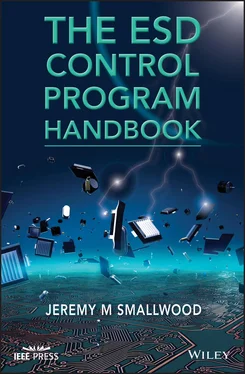1 ...6 7 8 10 11 12 ...24 Last, but definitely not least, I would like to thank my wife Jan for her good‐natured tolerance of my absent mindedness and lack of communication when engrossed in my work, and my daughter Alia for helping improve some of my photographs in preparation for publication in this book.
1 Definitions and Terminology
As with any specialist subject there are many terms that are the “jargon” of the subject that can be confusing to the newcomer. There are also terms that have specific meanings in the context of these standards but may have different meanings in common parlance. The intention here is not to give strict and rigorous academic definitions, but to assist the newcomer to the field to understand the following chapters.
Sometimes a range of meanings is common in different industries. For example, the terms conductive , static dissipative , insulative or insulating , and antistatic can mean many different things to different people from different industry areas or in the context of different standards or electrostatic discharge (ESD) control product types. In most cases, only the meaning common in ESD control, and in particular in the context of the IEC 61340‐5‐1 and ANSI/ESD S20.20 and related standards, is emphasized here.
The task of supervising an ESD control program is often given to personnel from many technical and educational backgrounds. For this reason, the minimum of prior technical knowledge is assumed in this book.
Despite this, some of the terms used in this document are defined with basic mathematical relationships given where appropriate. This is because simple mathematics often helps to clarify the subject and, in some cases, may be essential to helping the user understand how to specify aspects of an ESD control program. In many cases, these aspects, and their practical importance and application, are discussed further in Chapter 2.
1.1 Scientific Notation and SI Unit Prefixes
In electrostatics and ESD work, we often have to deal with very large or very small numbers. For example, the resistance of a material may be measured to be 10 000 000 000 Ω. For convenience and clarity, we use scientific notation and SI unit prefixes as shorthand for numbers ( http://physics.nist.gov/cuu/Units/prefixes.html).
In scientific notation, the number is rewritten in the form a × 10 b, where a lies between 1 and 10, and b is the number of decimal places a must be shifted to get the full number. This is probably most easily understood by examples of resistance and capacitance ( Table 1.1). Sometimes, when the number a is simply 1, it is omitted.
Table 1.1Examples of use of scientific notation and SI prefixes.
| Value |
Scientific notation |
SI prefix |
| 150 Ω |
1.5 × 10 2Ω |
150 Ω |
| 22 000 Ω |
2.2 × 10 4Ω |
22 kΩ |
| 35 000 000 Ω |
3.5 × 10 7Ω |
35 MΩ |
| 1 000 000 000 Ω |
1.0 × 10 9Ω or 10 9Ω |
1 GΩ |
| 1 000 000 000 000 Ω |
1.0 × 10 12Ω or 10 12Ω |
1 TΩ |
| 0.000 022 F |
2.2 × 10 −5F |
22 μF |
| 0.000 000 001 F |
1.0 × 10 −9F or 10 −9Ω |
1 nF |
| 0.000 000 000 15 F |
1.5 × 10 −10F |
150 pF |
| 0.000 000 000 001 F |
1.0 × 10 −12F |
1 pF |
1.2 Charge, Electrostatic Fields, and Voltage
1.2.1 Charge
The charge is a property of elementary particles – electrons and protons – that make up the atoms of all materials. All materials are made up of positively charged atomic nuclei and negative electrons (Cross 1987). The charge on a proton in the nucleus is labeled positive, and the charge on an electron is labeled negative. The charge effects of a proton are equal and opposite to those of an electron, so if a proton and electron are together in an atom, their effects cancel exactly. In this case, the atom is neutral. Atoms of different elements have many protons and electrons, depending on the particular element. For example, a hydrogen atom has 1 proton and 1 electron, and a carbon atom has 12 protons in the nucleus and 12 electrons surrounding it. An object or material is made of huge numbers of atoms and so extraordinary numbers of electrical charges.
When talking of static electricity, it is often said that charge is “generated” in certain circumstances. That is not so – all that happens is that a small number of negative charges become separated from their positive companions in a material and end up in a different place. For every negative charge appearing somewhere, there must be a positive charge appearing somewhere else. An object is described as charged if it has a net imbalance of the number of positive and negative charges that it contains. The electrical effects of the charges are no longer balanced, and a net static electrical charge exists at that location. It is this net charge imbalance that we are referring to when we talk about the charge on an object or material.
The unit of charge is the coulomb (C). In practice, the coulomb is a rather large amount of charge and microcoulombs (μC, 10 −6C), nanocoulomb (nC, 10 −9C), or even picocoulombs (pC, 10 −12C) are more usual. A single electron or proton has a charge of 1.6 × 10 −19C. So, an object having even 1nC of net charge has a large number, 6.2 × 10 9, of unneutralized electrons or protons.
Ions are very small particles having a small electrostatic charge. They are naturally present in the air but may also be generated deliberately or accidentally around objects at high voltage.
Charges are naturally present in atoms. Protons in the atomic nucleus have positive charge, and electrons in the atom have negative charge. A negative ion is formed when a particle gains one or more electrons. A positive ion is formed when a particle loses one or more electrons. Ions may consist of free electrons, single atoms, many atoms, or molecules (Wikipedia 2018). Sometimes these ions may become attached to larger particles.
1.2.3 Dissipation and Neutralization of Electrostatic Charge
Where there is an imbalance of charges present, there will usually be voltage differences.
Charges exert forces on each other and create an electrostatic field in which various effects occur. Like charges repel each other, and unlike charges attract each other.
If like charges have built up in a region, they repel each other, and if they are able to move, they will move apart and gradually spread out and dissipate. Unlike charges will be attracted and move together.
When opposite polarity charges are sufficiently close together, their effects cancel, and the charge is said to be neutralized.
1.2.4 Voltage (Potential)
Electric potential is defined in terms of the work done in moving a charge from one place to another in an electric field (Cross 1987). If a charge Q is moved a distance s against a uniform electric field E , the potential difference V between the start and end positions is

The energy taken to move a charge between two points is the same, no matter what route is taken between the points. Potential difference is measured in volts (V) and is often referred to as voltage . The unit volt (V) is equivalent to joules per coulomb. Voltage is a measure of the potential energy at a point and is perhaps analogous to pressure in a fluid system or height in a gravitational system.
Читать дальше













